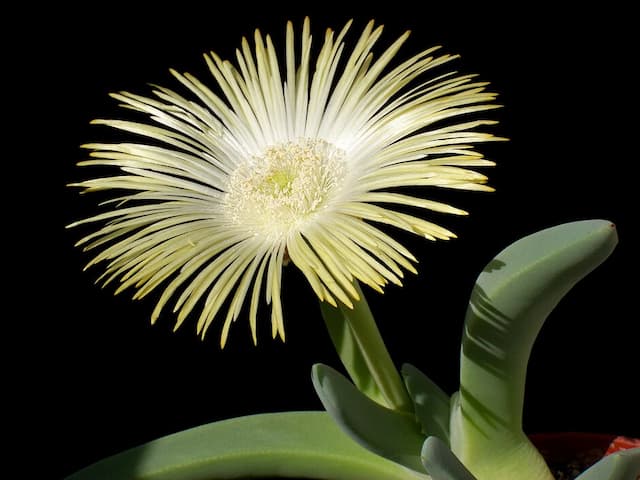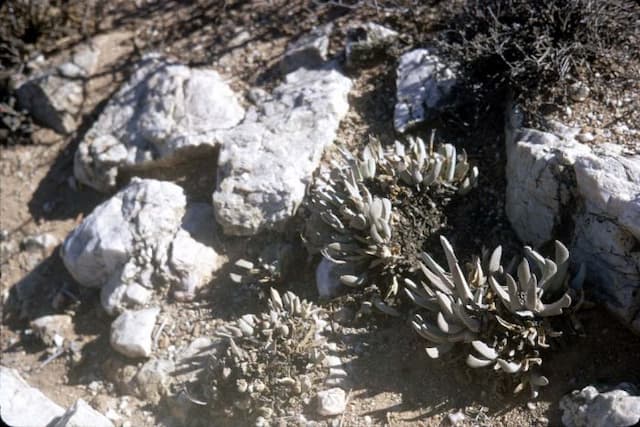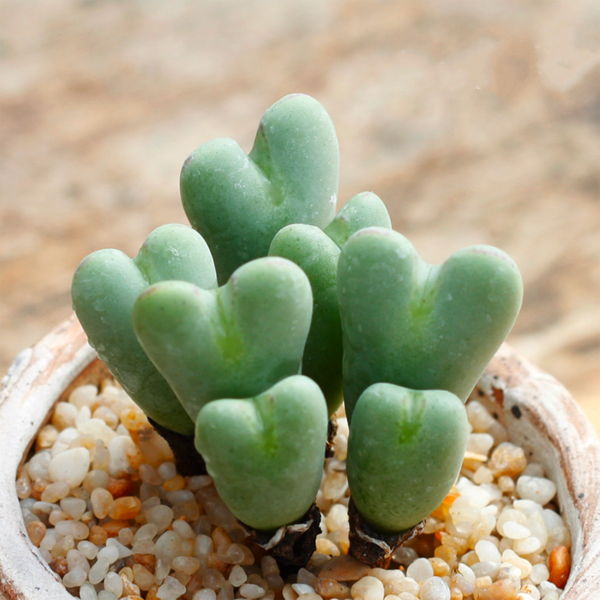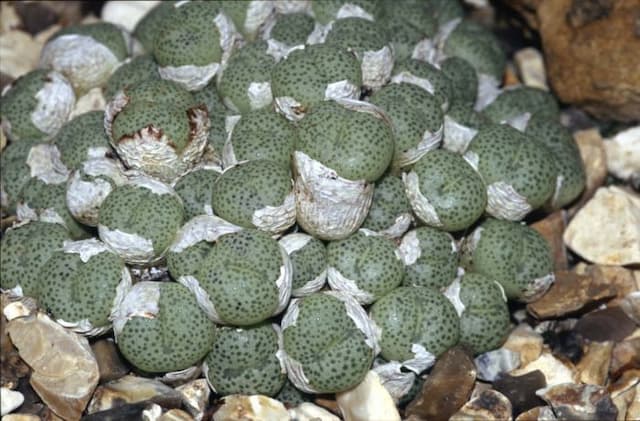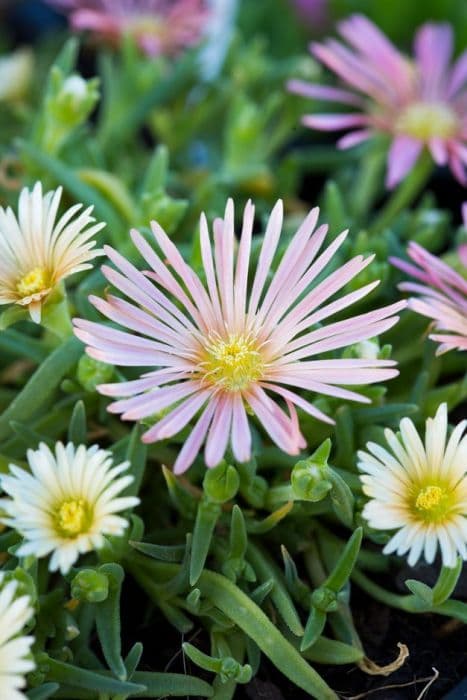Split Rock Pleiospilos bolusii

ABOUT
Commonly known as the Split Rock plant, Pleiospilos bolusii is a small, fascinating succulent that somewhat resembles a rock or a piece of the surrounding environment where it is native. In appearance, it features a pair of thick, fleshy leaves that are grey-green in color, with a texture that can be described as rough and stone-like. These leaves are shaped almost like a pair of swollen hemispheres or split stones, which is where it gets its common name. The surface of the leaves is dotted with small, darker spots that can vary in color from brown to darker green, adding to its camouflaged, rock-like appearance. The Split Rock plant has a very unique survival adaptation – its leaves can store water, allowing the plant to thrive in arid conditions. The leaves are often tightly pressed against each other, creating a crevice or slit at the center, which is where the new leaves or flowers emerge. When this succulent does flower, typically during the fall or winter months, its daisy-like blooms appear from the central split, contrasting with the leaf color. These blossoms can be yellow, orange, or occasionally other shades, depending on the specific variety and are usually quite large in proportion to the plant itself. The growth habit of the Split Rock is low and compact, staying close to the ground and blending seamlessly with its natural rocky terrain. This plant is also slow-growing, which means it maintains its neat, contained form for extended periods. It's a popular choice among succulent enthusiasts for rock gardens, windowsills, and as an indoor houseplant due to its curious rock mimicry and striking blossoms.
About this plant
 Names
NamesFamily
Aizoaceae
Synonyms
Split Rock, Cleft Stone, Mimicry Plant, Liver Plant, Stone Plant
Common names
Pleiospilos tricolor, Pleiospilos pedunculatus, Pleiospilos jacobsenii, Pleiospilos nellii.
 Toxicity
ToxicityTo humans
The plant commonly known as Split Rock is generally not considered toxic to humans. There is no significant evidence indicating that ingestion of Pleiospilos bolusii causes poisoning, therefore symptoms of toxicity are not typically associated with this plant.
To pets
Similarly, the Split Rock is not commonly known to be toxic to pets. It does not typically pose a threat if ingested by animals such as cats and dogs, and there are no well-documented symptoms of poisoning associated with Pleiospilos bolusii. However, as with any non-food item, ingestion of large amounts could potentially lead to gastrointestinal discomfort or blockages.
 Characteristics
CharacteristicsLife cycle
Perennials
Foliage type
Evergreen
Color of leaves
Grey-green
Flower color
Yellow
Height
0.1 feet (3 cm)
Spread
0.2 feet (6 cm)
Plant type
Succulent
Hardiness zones
10
Native area
South Africa
Benefits
 General Benefits
General Benefits- Low Maintenance: The Split Rock (Pleiospilos bolusii) is a succulent that requires minimal care, making it ideal for those with busy schedules or who are new to plant keeping.
- Drought-Tolerant: Adapted to arid environments, the Split Rock can survive long periods without water, reducing the need for frequent watering.
- Unique Appearance: With its rock-like appearance and beautiful flowers, the Split Rock is an attractive addition to any indoor space, adding aesthetic value.
- Long Lifespan: Succulents like the Split Rock can live for many years with proper care, providing a long-lasting decorative element.
- Compact Size: The plant's small size makes it perfect for growing in containers, suitable for limited space like small apartments or desks.
- Easy Propagation: Split Rock can be easily propagated from leaves or offsets, making it simple to create more plants to expand your collection or share with friends.
 Medical Properties
Medical PropertiesThis plant is not used for medical purposes.
 Air-purifying Qualities
Air-purifying QualitiesThis plant is not specifically known for air purifying qualities.
 Other Uses
Other Uses- Photographic subjects: Due to their unique, rock-like appearance, Split Rock plants are often used by photographers as interesting subjects for macro photography and plant portraiture.
- Educational tools: Botany educators sometimes use Pleiospilos bolusii as a demonstration species to teach about succulent adaptations and CAM (Crassulacean acid metabolism) photosynthesis.
- Stress relief: Caring for a Split Rock can serve as a form of stress relief or therapy, encouraging mindfulness and a connection with nature.
- Artistic inspiration: The distinctive look of Pleiospilos bolusii inspires artists and craftsmen in their works, from painting and sculpture to textile designs.
- Culinary curiosity: Although not commonly eaten, indigenous people sometimes used the plant as a moisture source or emergency food.
- Decor for miniature landscapes: These plants are often used in miniature gardening and fairy gardens due to their small size and interesting shape.
- Collector’s item: Succulent enthusiasts collect Pleiospilos bolusii and other rare succulents for their personal botanical collections.
- Living gifts: Due to their low maintenance nature, Split Rocks are popular as living gifts for plant lovers, especially those new to gardening.
- Water conservation education: Split Rock plants are used to educate on water-wise gardening and the importance of choosing drought-tolerant plants in arid regions.
- Geomorphology study: Scientists study these plants to understand how they mimic their rocky surroundings, a phenomenon known as geomorphological mimicry.
Interesting Facts
 Feng Shui
Feng ShuiThe Split Rock is not used in Feng Shui practice.
 Zodiac Sign Compitability
Zodiac Sign CompitabilityThe Split Rock is not used in astrology practice.
 Plant Symbolism
Plant Symbolism- Resilience: Pleiospilos bolusii, commonly known as Split Rock, is able to survive in harsh arid environments, symbolizing the ability to thrive despite difficult circumstances.
- Adaptation: The plant's capacity to store water in its leaves represents the skill to adapt and make the most of available resources.
- Patience: Split Rock grows slowly and blooms infrequently, embodying the virtue of patience and the anticipation of reward over time.
- Self-Sufficiency: Its survival in sparse conditions without much external support is emblematic of independence and self-reliance.
- Conservation: Split Rock's minimal water needs are a symbol of conservation, reminding us to be mindful of our consumption and to value sustainability.
 Water
WaterSplit Rock or Pleiospilos bolusii should be watered sparingly due to its succulent nature, mimicking drought conditions it's accustomed to in its native habitat. It's crucial to allow the soil to completely dry out between waterings. During the summer, water approximately once every three to four weeks with about 2-3 ounces of water each time. In the winter months, reduce watering to once every other month, or if the leaves are still full and plump, you may withhold water altogether. Adjust watering based on the humidity and light conditions, being careful not to overwater to prevent root rot.
 Light
LightSplit Rock requires bright, indirect sunlight to thrive. The best spot for this plant is near a south-facing window where it can receive ample light without the risk of leaf burn from direct sun exposure. Avoid low light conditions, as these can lead to etiolation and poor health of the plant.
 Temperature
TemperatureSplit Rock prefers temperatures ranging between 50 to 80 degrees Fahrenheit. It can survive temperature dips down to 40 degrees Fahrenheit, but for optimal growth, keeping it in the higher end of its preferred temperature range is ideal. It's important to protect the Split Rock from frost, as freezing temperatures can damage the plant.
 Pruning
PruningPruning is usually not necessary for Split Rock plants. However, if there are dead or damaged leaves, they can be gently removed to maintain the plant's appearance and to prevent potential fungal infections. The best time for this is in the spring or early summer when the plant is actively growing.
 Cleaning
CleaningAs needed
 Soil
SoilSplit Rock (Pleiospilos bolusii) thrives in a well-draining soil mix, such as a cactus or succulent potting mix combined with extra perlite or pumice for improved drainage. The ideal pH for this soil mix should range from slightly acidic to neutral (6.0 to 7.5).
 Repotting
RepottingSplit Rock plants should be repotted every few years or when they outgrow their pots, which is typically every 2 to 4 years for an average-sized plant.
 Humidity & Misting
Humidity & MistingSplit Rock prefers a dry environment with low humidity levels, mimicking its natural arid habitat.
 Suitable locations
Suitable locationsIndoor
Place Split Rock in bright light indoors, water sparingly.
Outdoor
Grow Split Rock in full sun to partial shade outside.
Hardiness zone
9-11 USDA
 Life cycle
Life cyclePleiospilos bolusii, commonly known as Living Stones, begins its life cycle as a seed which germinates when conditions are warm and moist, typically in autumn or early winter. The seedlings initially develop a pair of cotyledons, which are then followed by the characteristic stone-like succulent leaves that are a hallmark of Pleiospilos species. As it matures, Living Stones will go through a dormancy period during hot and dry seasons, conserving energy and water. During this time, older leaves will be reabsorbed to provide nutrients for the new leaves. After several years, once the plant has reached maturity, it will produce daisy-like flowers, typically in late summer or autumn, that open in the afternoon and close at sunset. Seeds are set following pollination, completing the cycle and allowing the plant to propagate.
 Propogation
PropogationPropogation time
Spring-Early Summer
Pleiospilos bolusii, commonly known as Split Rock, is most effectively propagated using seeds. The optimal time for sowing seeds is in the spring or early summer when temperatures are warm, ideally around 70°F (21°C). To propagate, first scatter the seeds evenly on a well-draining soil mix. Next, cover them with a very thin layer of sand or fine gravel to protect them without burying them too deeply. Ensure they receive adequate light, but not direct, scorching sunlight, and keep the soil slightly moist until germination occurs, which usually happens within a few weeks. Once seedlings have developed a couple of sets of true leaves, they can be carefully transplanted into their own pots. Regular care can then continue as they mature into adult plants.
